WORKING GROUP DRAFT – IN CONFIDENCEReport on Government Services 2025
PART C, SECTION 6: RELEASED ON 3 FEBRUARY 2026
6 Police services
The focus of performance reporting in this section is police services, covering the operations of the police agencies of each state and territory government, including the ACT community policing function performed by the Australian Federal Police.
The Indicator results tab uses data from the data tables to provide information on performance for each indicator in the Indicator framework. The same data in the data tables are also available in CSV format.
Data downloads
![]() 6 Police services data tables (XLSX 440.4 KB)
6 Police services data tables (XLSX 440.4 KB)
![]() 6 Police services dataset (CSV 1.0 MB)
6 Police services dataset (CSV 1.0 MB)
Refer to the corresponding table number in the data tables for detailed definitions, caveats, footnotes and data source(s).
Objectives for police services
Police services aim to contribute to a safe and secure community that enables people to undertake their lawful pursuits confidently and safely. To achieve these aims, governments seek to provide police services that:
- are accessible, and responsive to community needs, including disaster and emergency management
- support the judicial process to bring to justice people responsible for committing an offence
- provide safe custodial services
- are delivered with integrity, honesty and fairness
- promote safer behaviour on roads
- are capable of meeting current and projected future service demand.
Governments aim for police services to meet these objectives in an equitable and efficient manner.
Police services are the principal means through which state and territory governments pursue the achievement of a safe and secure environment for the community. Across jurisdictions, police activity can be grouped into four broad activity areas:
- Community safety – preserving public order and promoting a safer community
- Crime – investigating crime and identifying and apprehending offenders
- Road safety – targeted operations to reduce the incidence of traffic offences and through attendance at, and investigation of, road traffic collisions and incidents
- Judicial services – support to the judicial process including the provision of safe custody for alleged offenders.
Police services also respond to more general needs in the community – for example, working with emergency management organisations and a wide range of government services and community groups, and advising on general policing issues.
Police services are predominantly the responsibility of state and territory government agencies. They include the Australian Capital Territory community policing function performed by the Australian Federal Police (AFP) under an arrangement between the Australian Capital Territory and the Commonwealth Minister for Justice.
The Australian Government is responsible for the AFP. Data for the national policing function of the AFP and other national non-police law enforcement bodies (such as the Australian Criminal Intelligence Commission) is not included in this report.
Funding for police services comes almost exclusively from state and territory governments, with some limited specific purpose Australian Government grants. Nationally in 2023-24, total real recurrent expenditure (including user cost of capital, less revenue from own sources and payroll tax) was $17.0 billion with an average annual growth rate of 3.0% for the five years to 2023-24 (table 6A.1).
Client groups
All community members are recipients of policing services. Some members of the community have direct dealings with the police and can be considered specific client groups, for example:
- victims of crime
- people suspected of, or charged with, committing offences
- people reporting criminal incidents
- people involved in traffic-related incidents
- third parties (such as witnesses to crime and people reporting traffic-related incidents)
- people requiring police services for non-crime-related matters.
Staffing
Police staff comprise operational and non-operational staff.
An operational police staff member is any member whose primary duty is the delivery of police or police-related services.
Police staff are also categorised according to ‘sworn’ status. Sworn police officers exercise police powers, including the power to arrest, summons, caution, detain, fingerprint and search. Specialised activities may be outsourced or undertaken by administrative (unsworn) staff.
Operational police staff is considered the primary estimate of the number of police staff actively engaged in the delivery of police-related services. Nationally in 2023-24, 87.9% of the total 81,848 police staff were operational. This proportion has decreased every year since 2017-18 (92.2%). There were 267 operational police per 100,000 people nationally in 2023-24. Rates varied across jurisdictions from 213 to 298, except the Northern Territory with a rate of 757 (figure 6.1 and table 6A.2).
The rate of operational sworn police staff is also reported to give greater context to police service provision across Australia. Nationally in 2023-24, 70.3% of the total 81,848 staff were operational sworn police. This proportion has decreased every year since 2019-20 (74.7%). There were 213 operational sworn police per 100,000 people nationally in 2023-24. Rates varied across jurisdictions from 168 to 235, except the Northern Territory with a rate of 513 (figure 6.1 and table 6A.2).
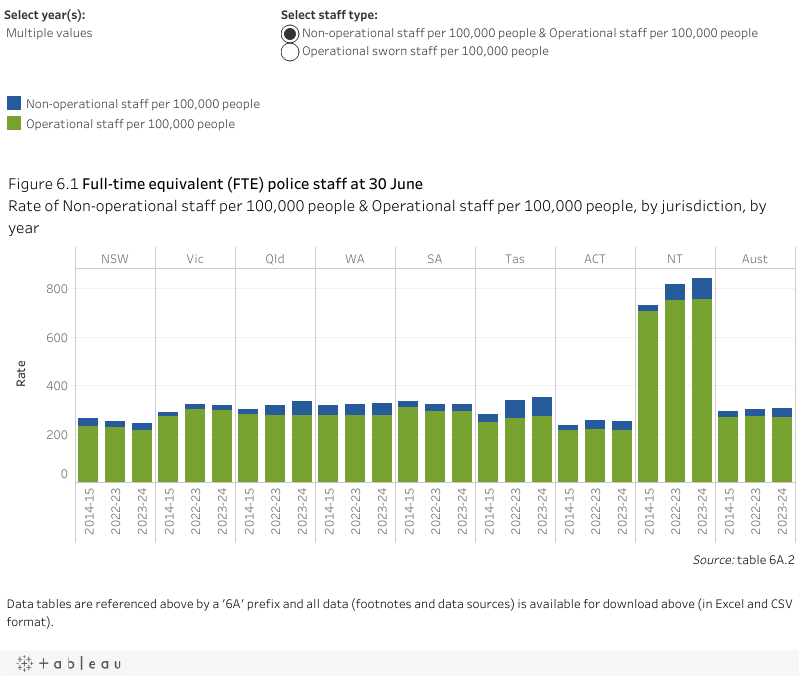
The performance indicator framework provides information on equity, effectiveness and efficiency, and distinguishes the outputs and outcomes of police services.
The performance indicator framework shows which data is complete and comparable in this report. For data that is not considered directly comparable, text includes relevant caveats and supporting commentary. Section 1 discusses data comparability and completeness from a report-wide perspective. In addition to the contextual information for this service area (refer to Context tab), the report's statistical context (section 2) contains data that may assist in interpreting the performance indicators presented in this section.
Improvements to performance reporting for police services are ongoing and include identifying data sources to fill gaps in reporting for performance indicators and measures and improving the comparability and completeness of data.
Outputs
Outputs are the services delivered (while outcomes are the impact of these services on the status of an individual or group) (refer to section 1). Output information is also critical for equitable, efficient and effective management of government services.
Outcomes
Outcomes are the impact of services on the status of an individual or group (refer to section 1).
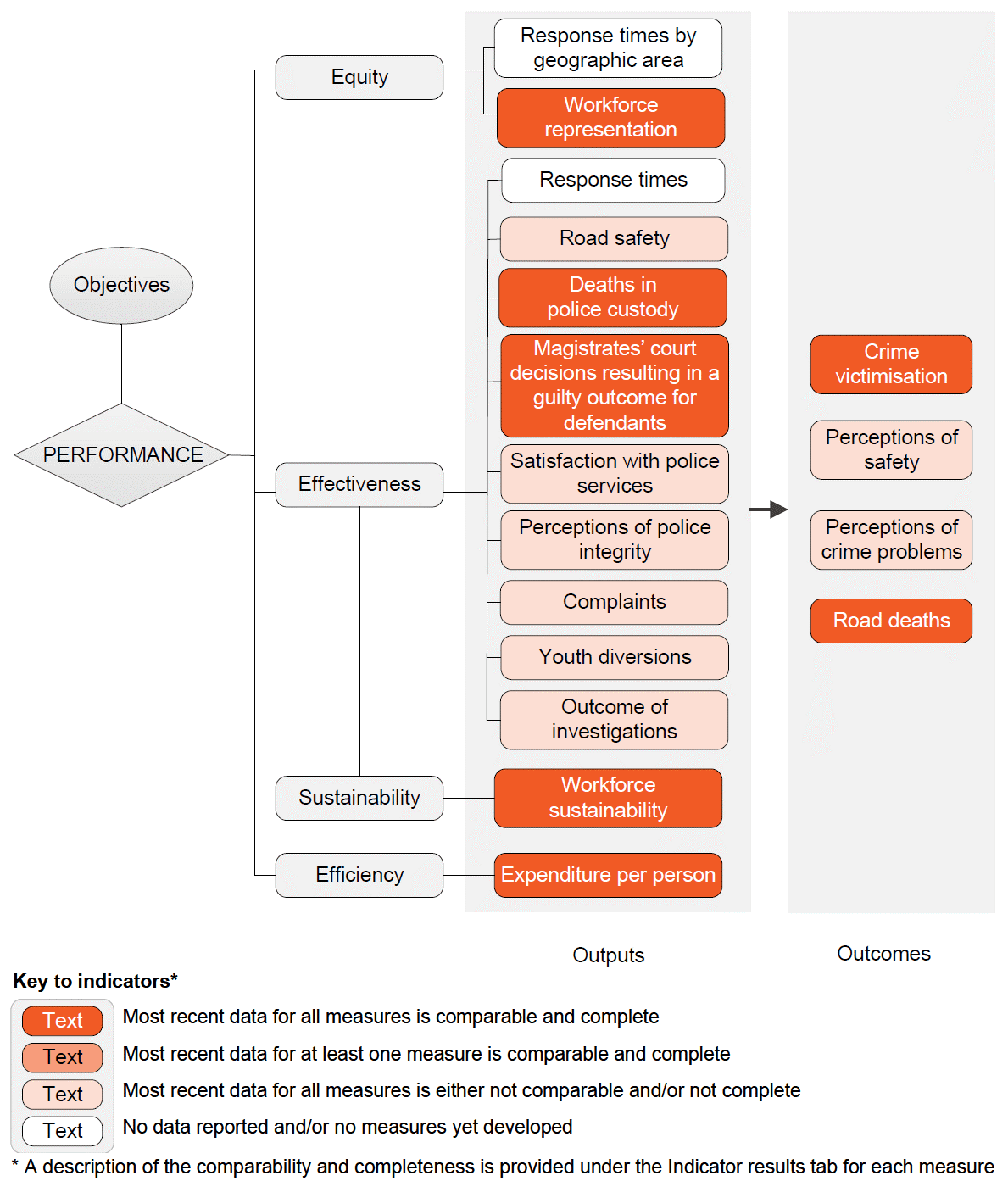
Performance – linked to Objectives
Outputs
Equity
- Response times by geographic area – no data reported and/or no measures yet developed
- Workforce representation – most recent data for all measures is comparable and complete
Effectiveness
- Response times – no data reported and/or no measures yet developed
- Road safety – most recent data for all measures is either not comparable and/or not complete
- Deaths in police custody – most recent data for all measures is comparable and complete
- Magistrates' court decisions resulting in a guilty outcome for defendants – most recent data for all measures is comparable and complete
- Satisfaction with police services – most recent data for all measures is either not comparable and/or not complete
- Perceptions of police integrity – most recent data for all measures is either not comparable and/or not complete
- Complaints – most recent data for all measures is either not comparable and/or not complete
- Youth diversions – most recent data for all measures is either not comparable and/or not complete
- Outcome of investigations – most recent data for all measures is either not comparable and/or not complete
Effectiveness – Sustainability
- Workforce sustainability – most recent data for all measures is comparable and complete
Efficiency
- Expenditure per person – most recent data for all measures is comparable and complete
Outcomes
- Crime victimisation – most recent data for all measures is comparable and complete
- Perceptions of safety – most recent data for all measures is either not comparable and/or not complete
- Perceptions of crime problems – most recent data for all measures is either not comparable and/or not complete
- Road deaths – most recent data for all measures is comparable and complete
A description of the comparability and completeness is provided under the Indicator results tab for each measure.
This section presents an overview of 'Police services' performance indicator results. Different delivery contexts, locations and types of clients can affect the equity, effectiveness and efficiency of police services.
Information to assist the interpretation of this data can be found with the indicators below and all data (footnotes and data sources) are available for download above as an excel spreadsheet and as a CSV dataset. Data tables are identified by a ‘6A’ prefix (for example, table 6A.1).
Specific data used in figures can be downloaded by clicking in the figure area, navigating to the bottom of the visualisation to the grey toolbar, clicking on the 'Download' icon and selecting 'Data' from the menu. Selecting 'PDF' or 'Powerpoint' from the 'Download' menu will download a static view of the performance indicator results.
‘Response times by geographic area’ is an indicator of governments’ objective to provide police services in an equitable manner. ‘Response times by geographic area’ is defined as the time taken in minutes between the initial receipt of a call for an urgent incident and arrival of the first police unit, by remoteness area. This indicator is under development.
‘Workforce representation’ is an indicator of governments’ objective to provide police services in an equitable manner.
‘Workforce representation’ is defined by two measures:
- Aboriginal and Torres Strait Islander staff – the proportion of police staff (operational and non‑operational) who are Aboriginal and Torres Strait Islander people compared with the proportion of the population aged 20–64 years who are Aboriginal and Torres Strait Islander people.
- Female staff – the proportion of police staff (operational and non-operational) who are female compared with the proportion of the population aged 20–64 years who are female.
Information on Aboriginal and Torres Strait Islander status is generally collected at recruitment and relates to staff who self-identify as being an Aboriginal and/or Torres Strait Islander person.
Similar proportions of police who are Aboriginal and Torres Strait Islander people or who are female compared to the population is desirable.
Aboriginal and Torres Strait Islander people might feel more comfortable when in contact with police services if they are able to liaise with Aboriginal and Torres Strait Islander staff. Similarly, women might feel more comfortable when in contact with police services if they are able to liaise with female police staff (particularly in situations involving family violence and sex offences). Workforce representation can also bring about positive cultural change.
Nationally in 2023-24, 2.4% of police staff (operational and non-operational) identified as Aboriginal and Torres Strait Islander (up from 2.3% in 2022-23) (figure 6.2). In all jurisdictions except the Australian Capital Territory, the proportion of Aboriginal and Torres Strait Islander police staff was lower than the proportion of Aboriginal and Torres Strait Islander people in the population (figure 6.2).
Nationally in 2023-24, 35.8% of police staff (operational and non-operational) were female, slightly higher than in 2022-23 (35.1%), and higher than 10 years ago (32.1% in 2014-15) (figure 6.3). In all jurisdictions across the 10 year time series, the proportion of female police staff was lower than the proportion of females in the population (table 6A.2).
Nationally in 2023-24, 27.9% of operational sworn police staff were female (proportions varied across jurisdictions from 22.9 to 35.2%) (table 6A.2).
‘Response times’ is an indicator of governments’ objective to provide police services that are accessible and responsive. ‘Response times’ is defined as the time taken in minutes between the initial receipt of a call for an urgent incident and arrival of the first police unit. This indicator is under development.
While there is currently no consistent public reporting of response times across states and territories, New South Wales, Queensland, Western Australia, South Australia and the Australian Capital Territory police publish response times data in annual reports. This information is summarised below.
- NSW Police Force report the number of urgent (imminent threat to life or property) response calls and the percentage attended within a target time of 12 minutes. In 2023-24, NSW Police Force responded to 218,551 urgent response calls, attending 79.8% of urgent response calls within the 12 minute target time (NSW Police Force 2024).
- Queensland Police Service report the percentage of code one and code two incidents attended within 12 minutes from triple 000 originating calls. Data includes geographic areas covered by the Queensland Computer Aided Dispatch (CAD) System. Code one and two incidents include very urgent matters when danger to human life is imminent and urgent matters involving injury or present threat of injury to person or property. In 2023-24, Queensland Police Service attended 74.3% of urgent matters within the 12 minute target time (Queensland Police Service 2024).
- WA Police Force aim to respond to 80% of priority one and two incidents – situations that require urgent attendance and include an imminent threat to life, serious offence or incident in progress – within 12 minutes in the Perth metropolitan area. WA Police Force report that they met this target in 85.8% of priority one and two incidents in 2023-24. The target for priority three incidents – situations that require routine attendance and include an offence in progress/suspect at the scene or the preservation of evidence – is 80% within 60 minutes in the Perth metropolitan area. WA Police Force report that they met this target in 84.2% of incidents in 2023-24 (WA Police Force 2024).
- SA Police reported that 92.0% of Grade one taskings in the metropolitan area were responded to within 15 minutes in 2023-24 (SA Police 2024). The target is 80% or above.
- ACT Policing report response time targets for three incident categories:
- Priority one incidents (life threatening or critical situations) – Average length of time to respond should be 8.2 minutes or less (7.5 minutes on average in 2023-24)
- Priority two incidents (situations where the information provided indicates that time is important but not critical) – Average length of time to respond should be 17.4 minutes or less (18.0 minutes on average in 2023-24)
- Priority three incidents (situations where there is no immediate danger to safety or property, but police attendance or response is needed no later than 48 hours from the initial contact by the complainant or a time agreed with the complainant) – 90% within 48 hours (95.2% achieved in 2023-24) (ACT Policing 2024).
Other jurisdictions do not report response times as part of their corporate reporting. Victoria cannot report response times due to current call taking and dispatch systems.
‘Road safety’ is an indicator of governments’ objective to promote safer behaviour on roads.
‘Road safety’ is defined by three measures:
- use of seatbelts – the proportion of people who had driven in the past six months and who reported that they had driven without wearing a seatbelt
- driving under the influence – the proportion of people who had driven in the past six months and who reported that they had driven when possibly over the alcohol limit
- degree of speeding – the proportion of people who had driven in the past six months and who reported that they had driven 10 kilometres per hour or more above the speed limit.
Road safety data is from the National Survey of Community Satisfaction with Policing (NSCSP). The NSCSP is an annual survey commissioned by all Australian state and territory police. The data is self-reported by participants and the survey samples people aged 18 years or over. (Until October 2015, it sampled people aged 15 years or over.) Due to a national change in the data collection methodology for the NSCSP, 2023-24 data is not comparable to results in previous years, is not comparable across jurisdictions and cannot be used to derive a national average.
A low or decreasing proportion of people who stated that they had driven without wearing a seatbelt, driven when possibly over the alcohol limit and/or driven 10 kilometres per hour or more above the speed limit is desirable.
The use of seatbelts, driving under the influence of alcohol and speeding are affected by a number of factors in addition to police activities, such as driver education and media campaigns.
In 2023-24, of survey respondents who had driven in the past six months:
- the proportion that reported driving without wearing a seatbelt varied from 3.3% (Australian Capital Territory) to 8.1% (Northern Territory)
- the proportion that reported driving when possibly over the blood alcohol limit varied from 8.2% (Victoria) to 13.8% (Western Australia)
- the proportion that reported travelling 10 kilometres per hour or more above the speed limit varied from 58.8% (South Australia) to 70.8% (Western Australia) (figure 6.4).
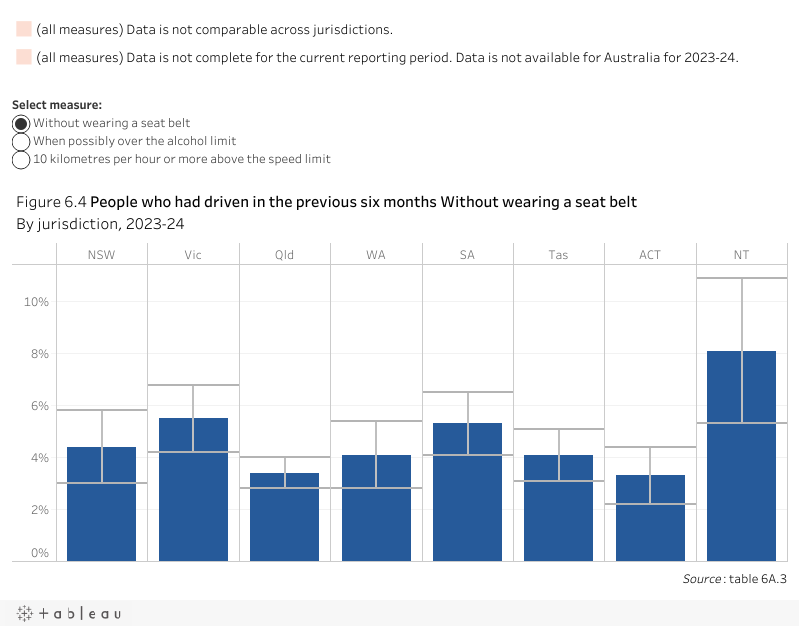
‘Deaths in police custody’ is an indicator of governments’ objective to provide safe custodial services.
‘Deaths in police custody’ is defined as deaths in police custody and custody-related operations, by Indigenous status.
These deaths are divided into two main categories:
- Category one: deaths in institutional settings (for example, police stations or lockups, police vehicles, during transfer from an institution), and other deaths in police operations where officers were in close contact with the deceased (for example, most raids and shootings by police).
- Category two: deaths during custody‑related operations – where officers did not have such close contact with the person to be able to significantly influence or control the person’s behaviour (for example, most sieges), and most cases where officers were attempting to detain a person (for example, a pursuit).
Zero or a decreasing number of deaths in custody and custody‑related operations is desirable.
Nationally in 2023-24, 27 people died in police custody, 5 of whom were Aboriginal and Torres Strait Islander people. The total number of deaths in police custody in 2023-24 is lower than 2022-23 (40 deaths), and the number of Aboriginal and Torres Strait Islander people who died in police custody in 2023-24 is lower than 2022-23 (10 deaths) (table 6.1).
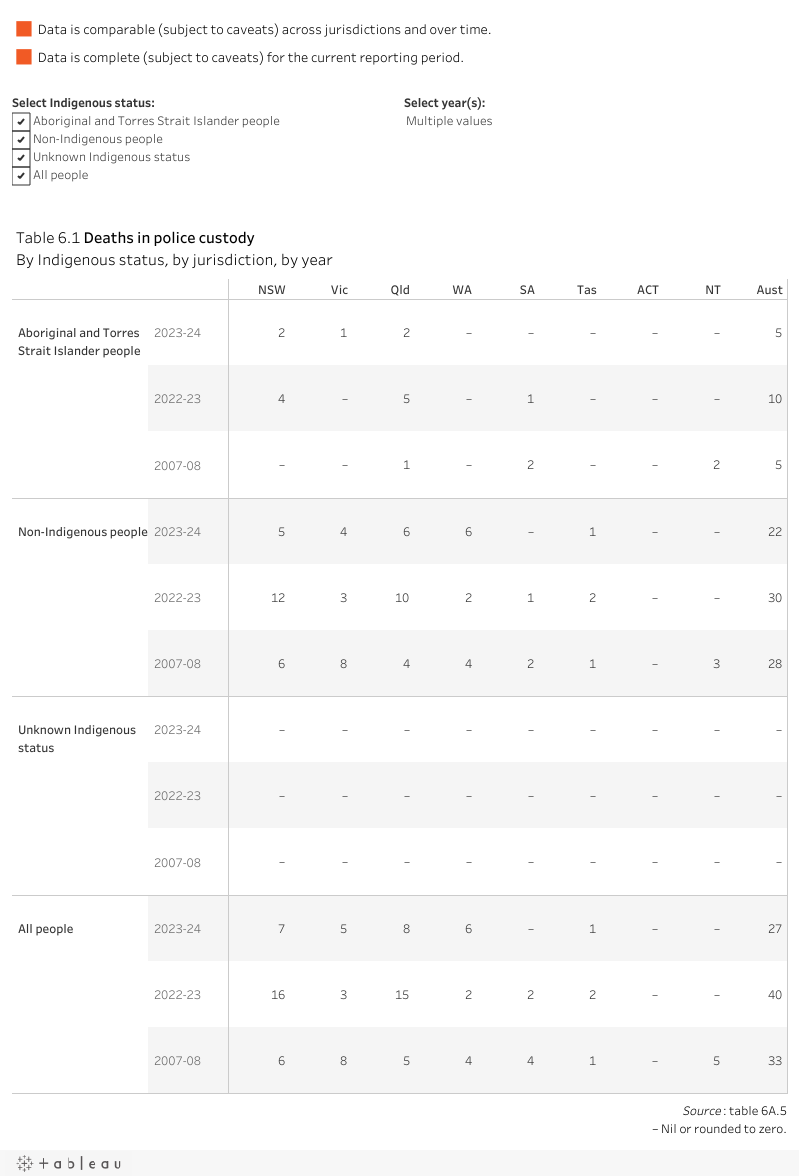
‘Magistrates’ court decisions resulting in a guilty outcome for defendants’ is an indicator of governments’ objective to support the judicial process to bring to justice people responsible for committing an offence.
‘Magistrates’ court decisions resulting in a guilty outcome for defendants’ is defined as the proportion of Magistrates’ court decisions where the defendant pled guilty, was found guilty by the court or was found guilty ex‑parte (that is, a finding of guilt in the defendant's absence). The defendant is a person or organisation against whom one or more criminal charges have been laid.
A high or increasing proportion of Magistrates’ court decisions where the outcome for the defendant is guilty is desirable. This can indicate police were effective in gathering evidence and only bringing to court charges with sufficient evidence to ensure a guilty outcome.
This indicator does not provide information on the number of cases where police have identified a likely offender but choose not to bring the likely offender to court due to several factors.
Nationally, in 2023-24, 97.2% of Magistrates’ court decisions resulted in a guilty outcome for defendants; a figure unchanged over the past four years (figure 6.5).
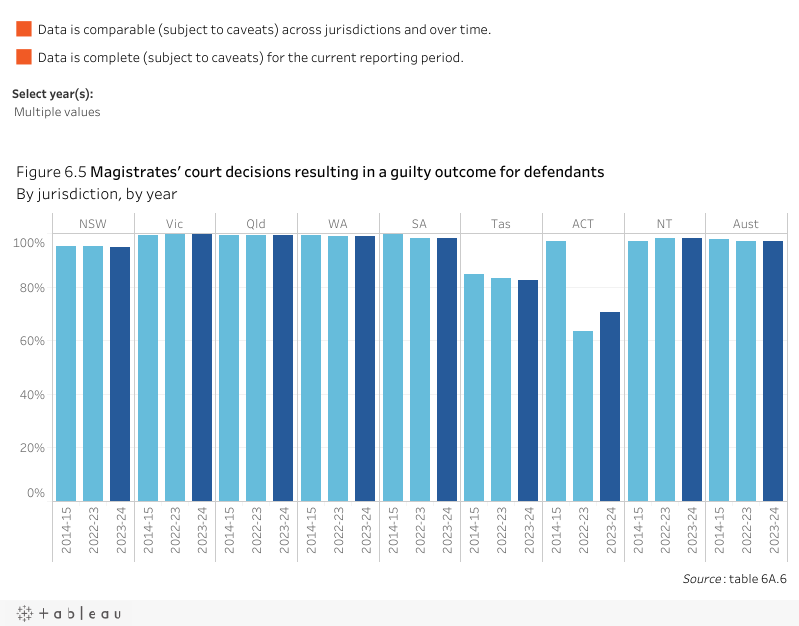
‘Satisfaction with police services’ is an indicator of governments’ objective of providing services that are accessible and responsive to community needs, including disasters and emergencies.
‘Satisfaction with police services’ is defined by three measures: the proportion of people who were ‘satisfied’ or ‘very satisfied’ with police services:
- in general (whether or not they had contact with police services)
- in their most recent contact
- in response to emergencies and disasters.
Satisfaction with police services data is from the National Survey of Community Satisfaction with Policing (NSCSP). The NSCSP is an annual survey commissioned by all Australian state and territory police. The data is self-reported by participants and the survey samples people aged 18 years or over. (Until October 2015, it sampled people aged 15 years or over.) Due to a national change in the data collection methodology for the NSCSP, 2023-24 data is not comparable to results in previous years, is not comparable across jurisdictions and cannot be used to derive a national average.
A high or increasing proportion of people who were ‘satisfied’ or ‘very satisfied’ is desirable.
In 2023-24:
- the proportion of surveyed adults who reported they were ‘satisfied’ or ‘very satisfied’ in general with the services provided by police varied from 55.5% (Victoria) to 72.7% (Tasmania)
- the proportion of surveyed adults who had contact with police in the previous 12 months who reported they were ‘satisfied’ or ‘very satisfied’ with their most recent contact varied from 66.8% (Northern Territory) to 75.0% (Western Australia)
- the proportion of surveyed adults who had contact with police in response to emergencies and disasters who reported they were ‘satisfied’ or ‘very satisfied’ with police service responses varied from 58.9% (Northern Territory) to 79.6% (Tasmania) (figure 6.6).
‘Perceptions of police integrity’ is an indicator of governments’ objective to provide services with integrity, honesty and fairness.
‘Perceptions of police integrity’ refers to public perceptions and is defined by three measures – the proportion of people who ‘agreed’ or ‘strongly agreed’ that police:
- treat people fairly and equally
- perform their job professionally
- are honest.
Perceptions of police integrity data is from the National Survey of Community Satisfaction with Policing (NSCSP). The NSCSP is an annual survey commissioned by all Australian state and territory police. The data is self-reported by participants and the survey samples people aged 18 years or over. (Until October 2015, it sampled people aged 15 years or over.) Due to a national change in the data collection methodology for the NSCSP, 2023-24 data is not comparable to results in previous years, is not comparable across jurisdictions and cannot be used to derive a national average.
A high or increasing proportion of people who ‘agreed’ or ‘strongly agreed’ with these statements is desirable.
Public perceptions might not reflect actual levels of police integrity, because many factors, including hearsay and media reporting, might influence people’s perceptions of police integrity.
In 2023-24, the proportion of survey respondents who ‘agreed’ or ‘strongly agreed’ that police:
- ‘treat people fairly and equally’ varied from 43.8% (New South Wales) to 67.2% (Tasmania)
- ‘perform their job professionally’ varied from 64.5% (New South Wales) to 79.3% (Tasmania)
- ‘are honest’ varied from 47.6% (New South Wales) to 68.1% (Tasmania) (figure 6.7).

‘Complaints’ is an indicator of governments’ objective to provide services with integrity, honesty and fairness.
‘Complaints’ is defined as the rate of complaints against sworn police staff by the public per 100,000 people in the population.
Complaints includes statements (written or verbal) by members of the public regarding police conduct when a person was in police custody or had voluntary or involuntary dealing with the police. They include sustained complaints, withdrawn complaints, dismissed complaints, and unresolved complaints, whether they are handled internally to the police service or by an external agency.
A low or decreasing rate of complaints is desirable.
A high or increasing rate of complaints does not necessarily indicate a lack of confidence in police. It can indicate greater confidence in complaints resolution. It is desirable to monitor changes in the rate of complaints to identify reasons for the changes and use this information to improve the manner in which police services are delivered.
Nationally in 2023-24, the rate of complaints per 100,000 people in the population varied across jurisdictions from 11 in Victoria, Western Australia and the Australian Capital Territory to 84 in South Australia (figure 6.8).
‘Youth diversions’ is an indicator of governments’ objective to provide police services that are accessible (in this case, access to non-court proceedings, where appropriate) and that support the judicial process to bring to justice people responsible for committing an offence.
‘Youth diversions’ is defined as the proportion of police proceedings for alleged youth offenders that were diverted by police using a non‑court proceeding.
The measure is reported by Indigenous status.
When police apprehend offenders, they can charge the offender (and proceed to court), or they can use their discretion to divert the offender away from this potentially costly, time consuming and stressful situation (for both the offender and victim).
Alleged youth offenders are aged 10 to 17 years at the date of proceeding. However, during the 2023-24 reporting period, the Northern Territory (August 2023) and the Australian Capital Territory (November 2023) raised the minimum age of criminal responsibility from 10 years of age to 12 years of age (AIHW 2023).
A proceeding is a legal action initiated against an alleged offender for an offence (or offences). Police proceedings represent a count for each separate occasion on which police initiate a legal action against an offender during the reference period. Aboriginal and Torres Strait Islander status is identified at the time of the proceeding by police.
Diversions include non‑court actions such as community conferences, diversionary conferences, formal (written) cautioning by police, family conferences, and other programs (for example, drug assessment/treatment). Non‑court actions that are initiated against offenders who would not normally be sent to court for the offence detected, and who are treated by police in a less formal manner (for example, issued informal (oral) cautions, informal warnings or infringement/penalty notices), are not included.
A high or increasing number of youth diversions, as a proportion of youth offenders is desirable. Not all diversionary options are available or subject to police discretion in all jurisdictions. In addition, young offenders who commit a serious offence or an offence specified in applicable legislation cannot be diverted. This limits opportunities for youth diversion. This indicator does not provide information on the relative success or failure of diversionary mechanisms.
In 2023-24, four jurisdictions (Victoria, Western Australia, the Australian Capital Territory and the Northern Territory) reported an increase from 2022-23 in the proportion of all young offenders diverted from the justice system, and two jurisdictions (Victoria and Western Australia) reported an increase in the proportion of young Aboriginal and Torres Strait Islander offenders diverted from the justice system. In all jurisdictions in 2023-24, a higher proportion of non-Indigenous young offenders were diverted than Aboriginal and Torres Strait Islander young offenders, noting in 2023-24 the Northern Territory was unable to disaggregate youth diversions by Indigenous status (table 6.2).
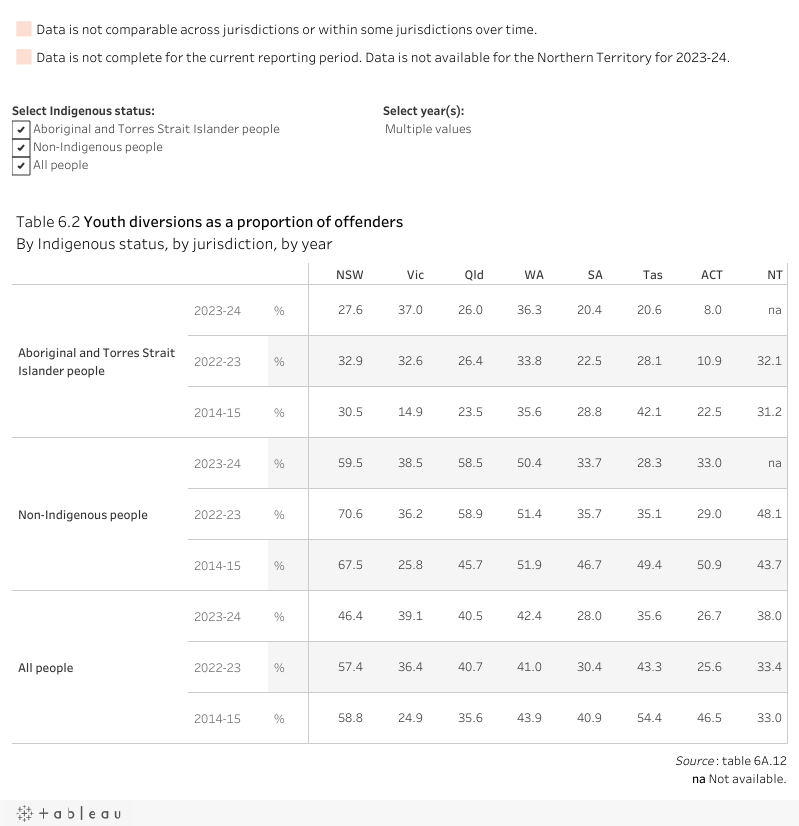
‘Outcome of investigations’ is an indicator of governments’ objective to support the judicial process to bring to justice people responsible for committing an offence.
‘Outcome of investigations’ is defined by two measures of the status of a police investigation after 30 days from the recording of the incident by police:
- the proportion of all investigations that were finalised
- the proportion of all finalised investigations where an offender was proceeded against.
Measures are reported for a range of offences:
- personal offences: homicide and related offences; sexual assault; armed robbery; and unarmed robbery
- property offences: unlawful entry with intent; motor vehicle theft; and other theft.
A high or increasing proportion of investigations that were finalised and investigations finalised where proceedings were instituted against the offender, is desirable.
The proportion of investigations finalised within 30 days of the offence becoming known to police varied across jurisdictions for a range of personal and property offences with proportions generally highest for homicide and related offences and lowest for sexual assault (figure 6.9a) In 2023:
- sexual assaults recorded the lowest proportion of personal crimes with investigations finalised within 30 days for NSW (24.3%), Queensland (42.0%), Western Australia (51.9%) Tasmania (32.0%) and the Australian Capital Territory (28.8%)
- homicide and related offences recorded the lowest proportion of personal crimes with investigations finalised within 30 days for South Australia (14.6%)
- unarmed robbery recorded the lowest proportion of personal crimes with investigations finalised within 30 days for Victoria (32.0%)
- unlawful entry with intent recorded the lowest proportion of property offences with investigations finalised within 30 days for Victoria (9.5%), Queensland (22.7%), Tasmania (16.9%) and the Australian Capital Territory (5.7%)
- motor vehicle theft recorded the lowest proportion of property offences with investigations finalised within 30 days for New South Wales (13.3%)
- other theft recorded the lowest proportion of property offences with investigations finalised within 30 days for Western Australia (26.9%) and South Australia (5.7%) (figure 6.9a).
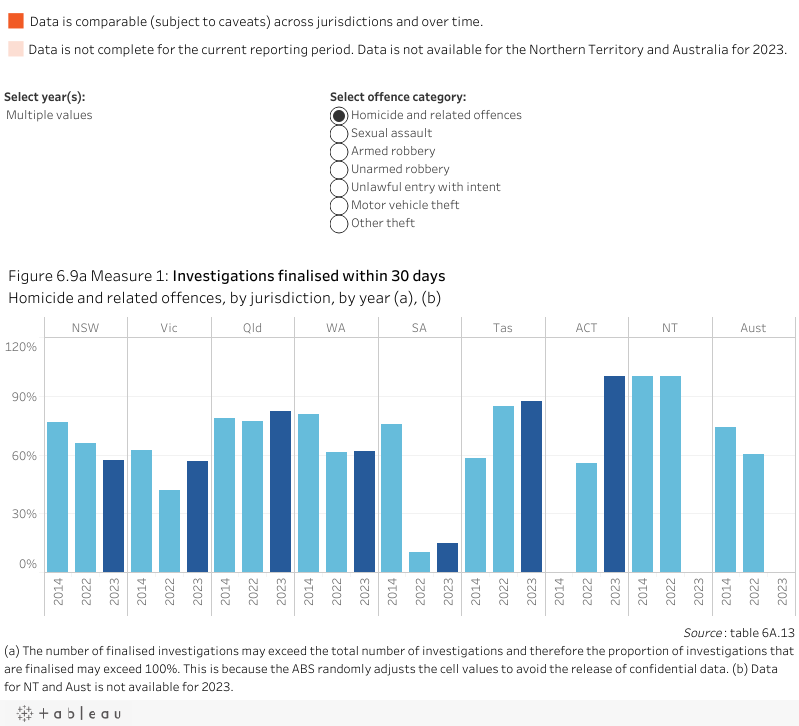
The proportion of finalised investigations for which proceedings had begun against the offender within 30 days of the offence becoming known to police varied across jurisdictions for a range of personal and property offences (figure 6.9b).
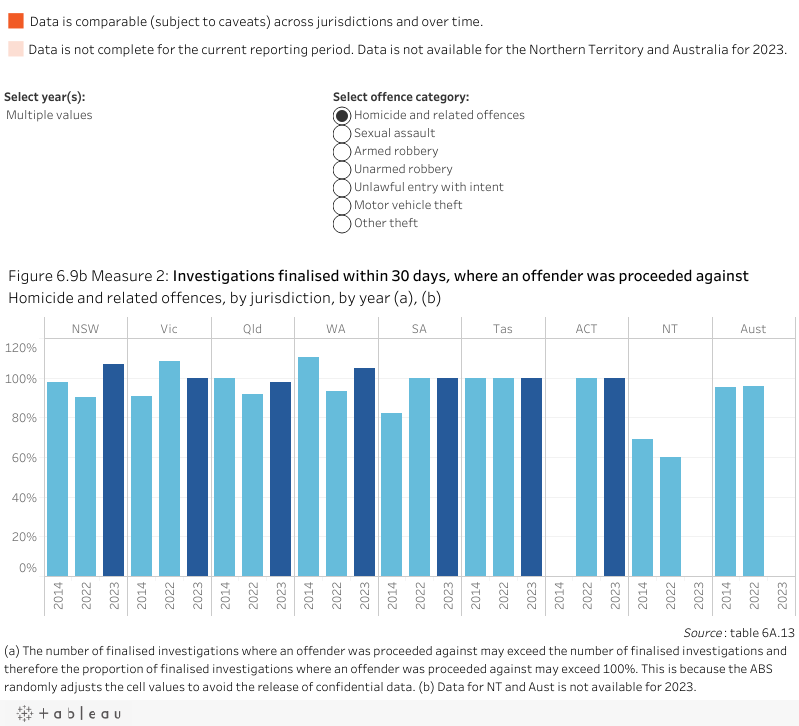
‘Workforce sustainability’ is an indicator of governments’ objective to provide sustainable police services. Police workforce sustainability relates to the capacity of the police workforce to meet current and projected future service demand. Workforce sustainability is defined as the proportion of the operational and non-operational workforce in 10-year age groups (under 30, 30–39, 40–49, 50–59, and 60 and over).
A low or decreasing proportion of the workforce in younger age groups could suggest potential workforce sustainability problems as older age workers enter retirement.
This measure is not a substitute for a full workforce analysis that allows for training, migration, changing patterns of work and expected future demand. They can, however, indicate that further attention should be given to workforce planning for police services.
A measure of police workforce attrition is currently under development for reporting in the future.
Nationally in 2023-24, the proportion of the operational police workforce aged under 50 years was 71.1%, while the proportion of the non-operational police workforce aged under 50 years was 64.5% (figure 6.10).
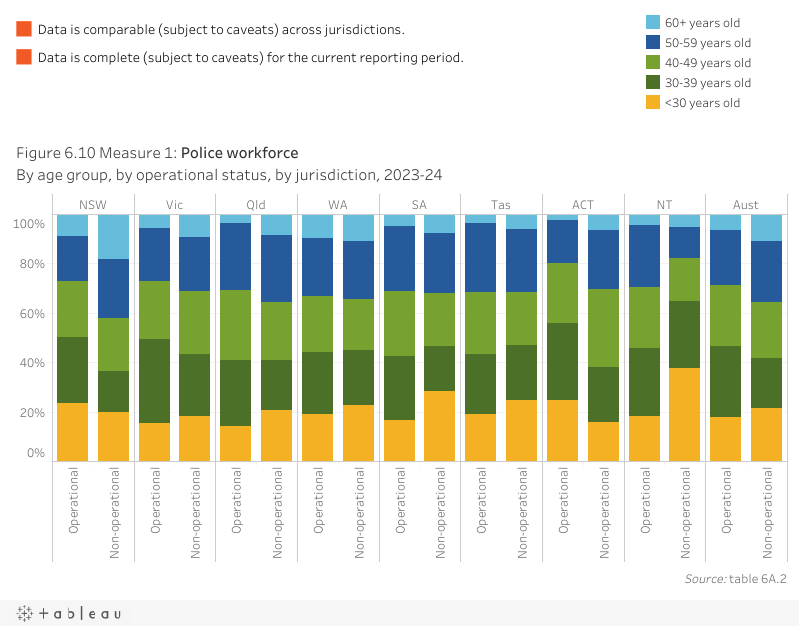
‘Expenditure per person’ is a proxy indicator of governments’ objective to provide police services in an efficient manner.
‘Expenditure per person’ is defined as real recurrent expenditure on policing per person in the population. All else being equal, low or decreasing expenditure per person is desirable. However, efficiency data should be interpreted with care. High or increasing expenditure per person might reflect poor efficiency but may also reflect changing aspects of the service or policing environment. Low expenditure per person may reflect more efficient outcomes or lower quality or less challenging crime and safety situations. The scope of activities undertaken by police services also varies across jurisdictions.
Real recurrent expenditure includes user cost of capital, less revenue from own sources and payroll tax.
Time series data for real recurrent expenditure and capital costs (including associated costs for the user cost of capital) for each jurisdiction is reported in table 6A.1. Information on treatment of assets by police agencies is presented in the Explanatory material.
Nationally in 2023-24, real recurrent expenditure on policing was $631 per person in the population. This figure has increased in real terms each year since 2016-17. Expenditure per person ranged from $505 to $739 across all jurisdictions, except the Northern Territory where it was $1,927 per person (figure 6.11).
‘Crime victimisation’ is an indicator of governments’ objective to contribute to a safe and secure community that enables people to undertake their lawful pursuits confidently and safely.
‘Crime victimisation’ is defined as the victimisation rate of selected personal and property crimes and is based on survey data from the Crime Victimisation Survey, a topic on the annual Multipurpose Household Survey conducted by the Australian Bureau of Statistics (ABS).
Data is reported for:
- personal crimes of physical assault, face‑to‑face threatened assault and robbery per 100,000 people aged 15 years or over; and for sexual assault, per 100,000 people aged 18 years or over
- property crimes of break‑in, attempted break‑in, motor vehicle theft, theft from a motor vehicle, malicious property damage and other theft, per 100,000 households.
A victim is a person (for personal crimes) or household (for property crimes) who has self‑reported as experiencing at least one incident in the last 12 months.
A low or decreasing rate of crime victimisation is desirable.
Personal crimes
ABS Crime Victimisation Survey data
Nationally, in 2023-24, there were an estimated 1,676.7 victims of physical assault, 2,061.7 victims of threatened assault (face-to-face incidents only), 503.7 victims of sexual assault and 234.3 victims of robbery per 100,000 people (figure 6.12a).
The ABS Crime Victimisation Survey also includes information on the proportion of survey respondents who experienced personal crimes and reported these crimes to police. Police reporting rates for personal crimes are available in table 6A.17. Nationally, in 2023-24, police reporting rates varied from 49.4% for surveyed victims of physical assault to 15.4% for surveyed victims of sexual assault (down from 31.2% for surveyed victims of sexual assault in 2022-23).

Police recorded crime victimisation data
Data on the rates of victims of police recorded crimes per 100,000 people for selected personal offences are available in table 6A.19 as context to ABS Crime Victimisation Survey data. Rates varied by offence type. Nationally in 2023, there were a reported 1.5 victims of homicide and related offences per 100,000 people and 136.3 victims of sexual assault per 100,000 people.
A subset of police recorded crime victimisation data related to family and domestic violence is available in table 6A.21. This data highlights the extent of police recorded crime linked to family and domestic violence. Nationally in 2023, there were a reported 0.6 victims of family and domestic violence related homicide, 52.8 victims of family and domestic violence related sexual assault and 0.6 victims of family and domestic violence related kidnapping per 100,000 people (figure 6.12b).
Data on police reported victims of sexual assault by age at incident is available in table 6A.22. In 2023, 57.6% of recorded victims of sexual assault were a child (under 18 years of age) at the time of the incident. As some offences reported in any given year might relate to historical offences, data is also provided on victims who were a child at the time of the incident and where the incident occurred within one year of the date of report. Nationally in 2023, there were 12,347 reported victims of child sexual assault where the incident occurred within one year of the date of report. In comparison, there were 20,903 child victims of sexual assault who reported a sexual assault (recent or historical) to police in 2023.
Caution should be used when comparing police recorded crime victimisation data and ABS Crime Victimisation Survey data. Data on police recorded victims of crime is obtained from police records and reflects victims of crime reported to, or detected by, police, whose details are subsequently recorded on police administrative systems. ABS Crime Victimisation Survey data is based on survey respondents' perceptions of the behaviours they experienced and includes crimes that are not reported to or detected by police.

Property crimes
ABS Crime Victimisation Survey data
Nationally, for every 100,000 households in 2023-24, an estimated 2,057.3 experienced a break-in, 2,139.6 an attempted break-in, 680.7 motor vehicle theft, 2,057.3 theft from a motor vehicle, 3,604.1 malicious property damage and 1,884.3 experienced other theft (figure 6.12c).
The ABS Crime Victimisation Survey also includes information on the proportion of survey respondents who experienced property crimes and reported these crimes to police. Police reporting rates for property crimes are available in table 6A.18. Nationally, in 2023-24, police reporting rates varied from 83.7% for surveyed victims of motor vehicle theft to 37.3% for surveyed victims of other theft.
Police recorded crime victimisation data
Data on the rates of victims of police recorded crimes per 100,000 people for selected property offences are available in table 6A.20 as context to ABS Crime Victimisation Survey data. Rates varied by offence type. Nationally in 2023 there were a reported 363.2 victims of unlawful entry where property was taken per 100,000 people and 226.8 victims of motor vehicle theft per 100,000 people.
As above, caution should be used when comparing police recorded crime victimisation data and ABS Crime Victimisation Survey data.

‘Perceptions of safety’ is an indicator of governments’ objective to contribute to a safe and secure community that enables people to undertake their lawful pursuits confidently and safely.
‘Perceptions of safety’ is defined by two measures – the proportion of people who felt ‘safe’ or ‘very safe’:
- at home alone during the night
- in public places, including walking alone in the neighbourhood during the day and night and travelling on public transport during the night.
Perceptions of safety data is from the National Survey of Community Satisfaction with Policing (NSCSP). The NSCSP is an annual survey commissioned by all Australian state and territory police. The data is self-reported by participants and the survey samples people aged 18 years or over. (Until October 2015, it sampled people aged 15 years or over.) Due to a national change in the data collection methodology for the NSCSP, 2023-24 data is not comparable to results in previous years, is not comparable across jurisdictions and cannot be used to derive a national average.
A high or increasing proportion of people who felt ‘safe’ or ‘very safe’ is desirable.
In 2023-24, the proportion of survey respondents who reported they felt ‘safe’ or ‘very safe’:
- home alone during the night varied from 58.3% (Northern Territory) to 89.2% (Australian Capital Territory)
- when walking locally during the night varied from 26.5% (Northern Territory) to 57.1% (Australian Capital Territory)
- when travelling on public transport during the night varied from 12.4% (Northern Territory) and 39.7% (New South Wales) (figure 6.13a).
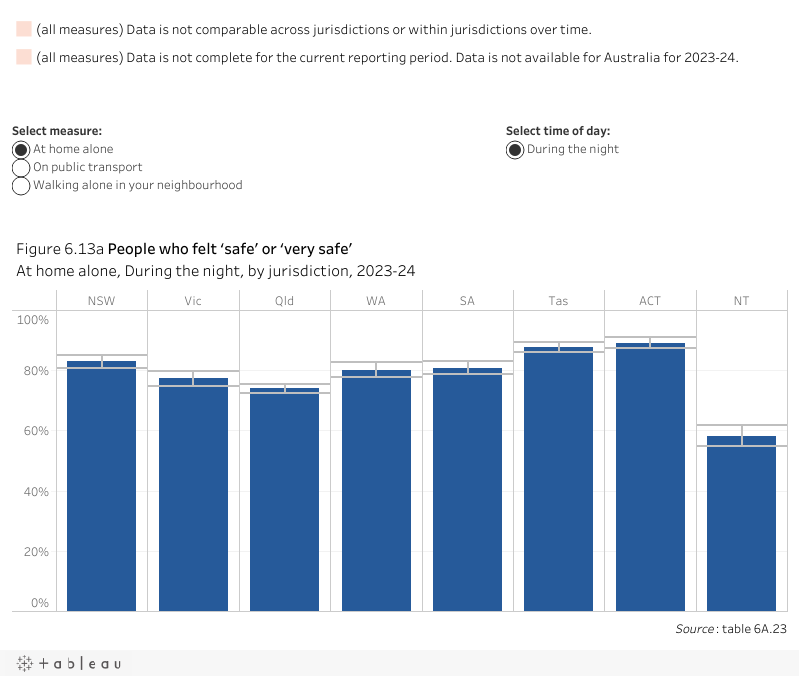
Data from the 2021-22 ABS Personal Safety Survey on self-reported feelings of safety is available in table 6A.25 to supplement data on perceptions of safety sourced from the National Survey of Community Satisfaction with Policing. Data from this survey is reported for females aged 18 years and over disaggregated by state and territory, and nationally for males aged 18 years and over.
Nationally, 88.5% of females felt safe at home alone after dark, compared to 97.2% of males. In addition, 63.0% of females did not walk alone after dark compared to 30.8% of males (figure 6.13b).
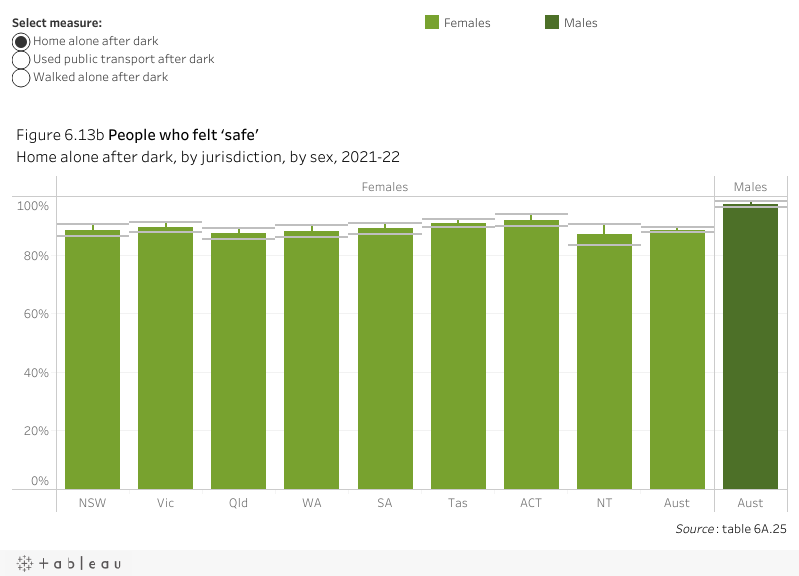
‘Perceptions of crime problems’ is an indicator of governments’ objective to contribute to a safe and secure community that enables people to undertake their lawful pursuits confidently and safely.
‘Perceptions of crime problems’ is defined as the proportion of people who thought that various types of crime were a ‘major problem’ or ‘somewhat of a problem’ in their neighbourhood.
This indicator measures perceptions of crime, as distinct from the actual level of crime (recorded crime data is available in 6A.19 and 6A.20). Perceptions of crime data is sourced from the National Survey of Community Satisfaction with Policing (NSCSP). The NSCSP is an annual survey commissioned by all Australian state and territory police. Data is self-reported by participants and the survey samples people aged 18 years or over. (Until October 2015, it sampled people aged 15 years or over.) Due to a national change in the data collection methodology for the NSCSP, 2023-24 data is not comparable to results in previous years, is not comparable across jurisdictions and cannot be used to derive a national average.
A low or decreasing proportion of people who thought the selected types of crime were a ‘major problem’ or ‘somewhat of a problem’ in their neighbourhood is desirable.
In 2023-24, the proportion of surveyed adults who reported illicit drugs to be either a ‘major problem’ or ‘somewhat of a problem’ in their neighbourhood varied from 37.9% (Australian Capital Territory) to 55.3% (Northern Territory). Also, the proportion of surveyed adults who thought speeding cars, dangerous or noisy driving to be a problem varied from 64.1% (Northern Territory) to 73.6% (Queensland) (figure 6.14).
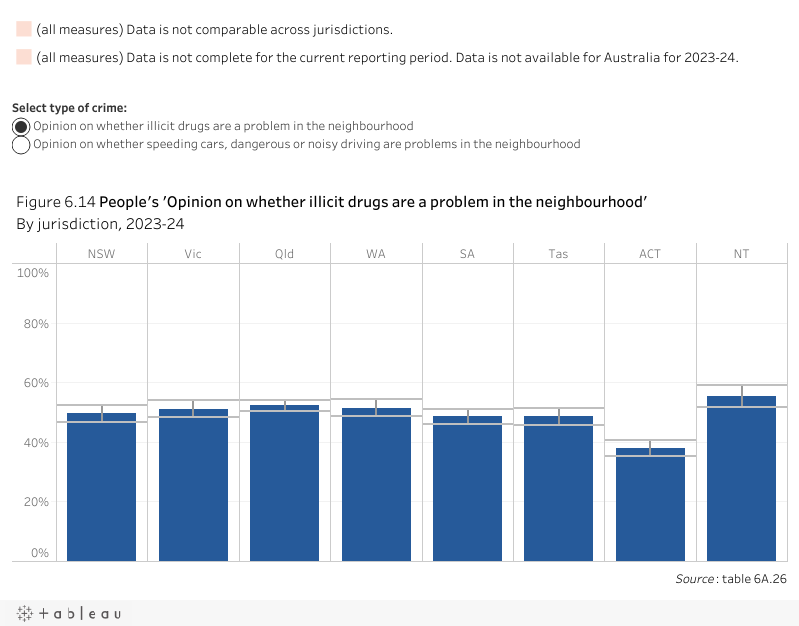
‘Road deaths’ is an indicator of governments’ objective to contribute to a safe and secure community that enables people to undertake their lawful pursuits confidently and safely.
‘Road deaths’ is defined as the rate of road deaths per 100,000 registered vehicles.
The Australian Road Deaths Database provides basic details of road transport deaths in Australia as reported by the police each month to state and territory road safety authorities.
No deaths or a decreasing rate of road deaths per 100,000 registered vehicles is desirable.
The rate of road deaths is affected by a number of factors in addition to activities undertaken by police services, such as the condition of roads, driver education and media campaigns.
Nationally in 2023-24, there were 6.0 road deaths per 100,000 registered vehicles. This is down from a rate of 6.5 road deaths 10 years ago (2014-15) but is the highest rate in five years (from a low of 5.5 in 2019-20) (figure 6.14). The 2023-24 rate reflects 1,311 road deaths nationally (table 6A.28).
Contextual data on traffic accident hospitalisations is available in table 6A.29. Nationally in 2022-23, there were 166.0 traffic accident hospitalisations per 100,000 registered vehicles, an increase from 2021-22 (153.9 per 100,000 registered vehicles) (figure 6.15).
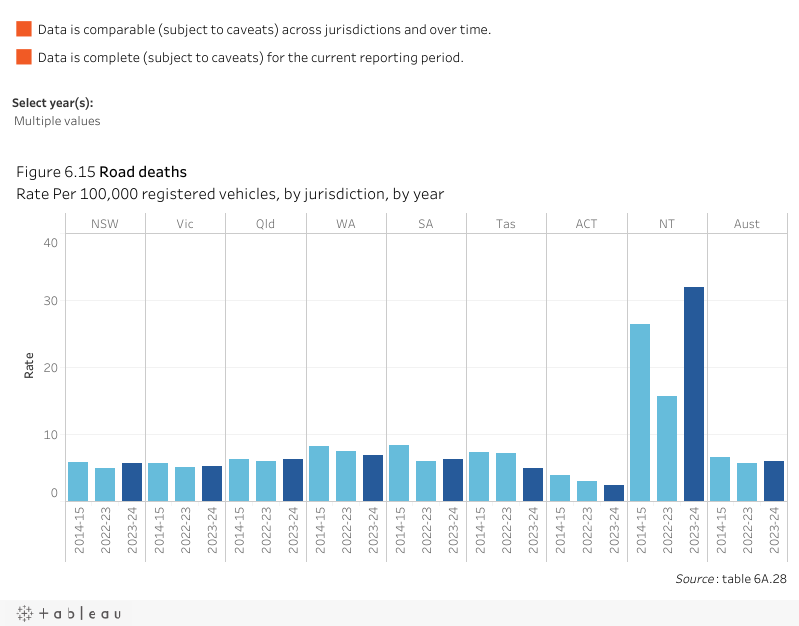
Performance indicator data for Aboriginal and Torres Strait Islander people in this section is available in the data tables listed below. Contextual data and further supporting information can be found in the 'Indicator results' tab and data tables.
| Table number | Table title |
|---|---|
| Table 6A.2 | Police staffing |
| Table 6A.5 | Deaths in police custody, by Indigenous status |
| Table 6A.12 | Youth diversions as a proportion of offenders, by Indigenous status |
NSWb | Vic | Qld | WA | SA | Tas | ACTc | NT | ||
|---|---|---|---|---|---|---|---|---|---|
| Revaluation methoda | Land | Market value | Fair value | Fair value | Fair value | Fair value | Fair Value | Market | Market |
| Buildings | Written down replacement value | Fair value | Fair value | Fair value | Fair value | Fair Value | Market | Market | |
| Other assets | Straight‑line depreciation over useful life | Fair value | Cost (aircraft are at market valuation) | Cost | Cost | Cost | Deprival | Cost ‑ only land and buildings revalued | |
| Frequency of revaluations (years) | Land | 3 | 5 | Annual over a four‑year rolling plan | Annual | 5 | 3 | na | 5 |
| Buildings | 3 | 5 | Annual over a four‑year rolling plan | Annual | 5 | 3 | na | 5 | |
| Other assets | Annual capitalisation of group | 5 | None except aircraft, revalued annually | na | na | na | 3 | 5 | |
| Useful asset lives (years)b,c | Buildings | Useful life/Lease term, determined individually | 1‑50 | 10‑169 | 50 (except for transport- ables, depreciated over 20) | Lease term (20‑60) | 5‑90 | 25‑59 | 20‑50 |
| Plant and equipment | 6.5‑10 | 1‑40 | 2‑17 | 4‑20 | 10 | 1‑40 | 3‑25 | 1‑10 | |
| IT equipmentd | 4 | 1‑5 | 3‑8 | 4‑40 | 3 | 5 | 3 | 3‑6 | |
| Office equipmente | 10 | 1‑15 | 4‑40 | 7 | 10 | 1‑40 | 5 | 5‑10 | |
| Motor vehiclesf | Owned vehicles 6.5 | 1‑10 | 2‑10 | 5‑10 | 3‑10 | 5 | 5 | 1‑10 | |
| Threshold capitalisation levels ($) | Buildings | 5,000 | 5,000 | 10,000 | 5,000 | 10,000 | 50,000 | na | 5,000 |
| IT equipment | – | 5,000 | 5,000 | 5,000 | 10,000 | 10,000 | 2,000 | 5,000 | |
| Other assets | 5,000 | 5,000 | 5,000 | 5,000 | 10,000 | 10,000 | 2,000 | 5,000 |
a Depreciated replacement cost; current value; market value (current (net) value, market selling price or exchange value); and deprival value may be either the depreciated replacement cost of an asset of a similar service potential or the stream of its future economic benefits. b Estimated as (1/depreciation rate). c ACT asset lives for some assets have been grouped with other classifications. d WA IT equipment includes communication equipment. e NSW office equipment includes computer software, furniture and fittings, firearms and musical instruments. Vic office equipment includes furniture. f Includes all transport equipment. However, marine equipment is amortised over 20 years and livestock over 8 years. Leased vehicles, including aircraft and vessels are amortised over the lease term. – Nil or rounded to zero. na Not available.
Source: State and territory governments (unpublished).
| Terms | Definition |
|---|---|
| Armed robbery | Robbery conducted with the use (actual or implied) of a weapon, where a weapon can include, but is not restricted to:
|
| Assault | The direct (and immediate/confrontational) infliction of force, injury or violence on a person(s) or the direct (and immediate/confrontational) threat of force, injury or violence where there is an apprehension that the threat could be enacted. |
| Cautioning | A formal method of dealing with young offenders without taking court proceedings. Police officers may caution young offenders instead of charging them if the offence or the circumstance of the offence is not serious. |
| Depreciation | The cost allocation of a physical asset over its useful life. Where possible, this should be based on current asset valuation. |
| Estimated resident population (ERP) | The official Australian Bureau of Statistics estimate of the Australian population. The ERP is derived from the five‑yearly Census counts and is updated quarterly between censuses. It is based on the usual residence of the person. |
| Full-time equivalent (FTE) | The equivalent number of full-time staff required to provide the same hours of work as performed by staff actually employed. A full-time staff member is equivalent to an FTE of one, while a part-time staff member is greater than zero but less than one. |
| Homicide and related offences | The unlawful killing or the attempted unlawful killing of another person. Includes murder, attempted murder and manslaughter. Excludes driving causing death. |
| Motor vehicle theft | The taking of another person’s motor vehicle illegally and without permission. It includes privately owned vehicles and excludes vehicles used mainly for commercial business/business purposes. |
| Non‑operational full‑time equivalent staff | Any person who does not satisfy the operational staff criteria, including functional support staff only. Functional support full‑time equivalent staff includes any person (sworn or unsworn) not satisfying the operational or operational support staff criteria (for example, finance, policy, research, personnel services, building and property services, transport services, and management above the level of station and shift supervisors). |
| Offender | A person who is alleged to have committed an offence. It differs from the definition used in section 8 (‘Corrective services’), where the term ‘offender’ refers to a person who has been convicted of an offence and is subject to a correctional sentence. |
| Operational staff | An operational police staff member (sworn or unsworn) is any member of the police force whose primary duty is the delivery of police or police related services to an external customer (where an external customer predominately refers to members of the public but may also include law enforcement outputs delivered to other government departments). Operational staff include general duties officers, investigators, traffic operatives, tactical officers, station counter staff, communication officers, crime scene staff, disaster victim identification, and prosecution and judicial support officers. |
| Other recurrent expenditure | Maintenance and working expenses; expenditure incurred by other departments on behalf of police; expenditure on contracted police services; and other recurrent costs not elsewhere classified. Expenditure is disaggregated by service delivery area. |
| Other theft | The taking of another person’s property with the intention of depriving the owner of the property illegally and without permission, but without force, threat of force, use of coercive measures, deceit or having gained unlawful entry to any structure, even if the intent was to commit theft. |
| Property crimes | Total recorded crimes against property, including:
|
| Real expenditure | Actual expenditure is adjusted for changes in prices. Time series financial data is adjusted to 2023‑24 dollars using the General Government Final Consumption Expenditure (GGFCE) chain price deflator (2023‑24 = 100). Refer to table 2A.26 and section 2 for more details. |
| Recorded crime | Crimes reported to (or detected) and recorded by police. |
| Registered vehicles | Total registered motor vehicles, including motorcycles. |
| Revenue from own sources | Revenue from activities undertaken by police, including revenue from the sale of stores, plant and vehicles; donations and industry contributions; user charges; and other revenue (excluding fine revenue and revenue from the issuing of firearm licenses). |
| Robbery | The unlawful taking of property from the immediate possession, control, custody or care of a person, with the intent to permanently deprive the owner of the property accompanied by the use, and/or threatened use of immediate force or violence. |
| Salaries and payments in the nature of salary | Includes:
|
| Sexual assault | Physical contact of a sexual nature directed towards another person where that person does not give consent, that person gives consent as a result of intimidation or fraud, or consent is proscribed (that is, the person is legally deemed incapable of giving consent as a result of youth, temporary/permanent (mental) incapacity or a familial relationship). Includes rape, attempted rape, indecent assault and assault with intent to commit sexual assault. Excludes sexual harassment not leading to assault. |
| Sworn staff | Sworn police staff recognised under each jurisdiction’s Police Act. |
| Total capital expenditure | Total expenditure on the purchase of new or second‑hand capital assets, and expenditure on significant repairs or additions to assets that add to the assets’ service potential or service life. |
| Total expenditure | Total capital expenditure plus total recurrent expenditure (less revenue from own sources). |
| Total FTE staff | Operational staff and non‑operational staff, including full‑time equivalent staff on paid leave or absence from duty (including secondment and training), as measured using absolute numbers for the whole reporting period. |
| Total number of staff | Full‑time equivalent staff directly employed on an annual basis (excluding labour contracted out). |
| Total recurrent expenditure | Includes:
|
| Unlawful entry with intent – involving the taking of property | The unlawful entry of a structure (whether forced or unforced) with intent to commit an offence, resulting in the taking of property from the structure. Includes burglary and break‑in offences. Excludes trespass or lawful entry with intent. |
| Unlawful entry with intent – other | The unlawful entry of a structure (whether forced or unforced) with intent to commit an offence, but which does not result in the taking of property from the structure. Excludes trespass or lawful entry with intent. |
| User cost of capital | The opportunity cost of funds tied up in the capital used to deliver services. Calculated as 8% of the current value of non‑current physical assets (excluding land). |
| Value of physical assets – buildings and fittings | The value of buildings and fittings under the direct control of police. |
| Value of physical assets – land | The value of land under the direct control of police. |
| Value of physical assets – other | The value of motor vehicles, computer equipment, and general plant and equipment under the direct control of police. |
AIHW (Australian Institute of Health and Welfare) 2023, Youth detention population in Australia 2023, https://www.aihw.gov.au/reports/youth-justice/youth-detention-population-in-australia-2023/contents/understanding-youth-detention-in-australia/raising-the-age-of-criminal-responsibility (accessed 7 October 2024).
NSW Police Force 2024, Annual Report 2023‑24, ![]() https://www.police.nsw.gov.au/__data/assets/pdf_file/0003/890805/FINAL_Annual_Report_2023-24.pdf (accessed 10 December 2024).
https://www.police.nsw.gov.au/__data/assets/pdf_file/0003/890805/FINAL_Annual_Report_2023-24.pdf (accessed 10 December 2024).
Queensland Police Service 2024, 2023-24 Annual Report, https://www.police.qld.gov.au/qps-corporate-documents/reports-and-publications/annual-report-2023-2024 (accessed 13 November 2024).
WA Police Force 2024, 2023-24 Annual Report, https://www.wa.gov.au/government/publications/wa-police-force-annual-report-2024 (accessed 13 November 2024).
SA Police 2024, 2023-24 Annual Report, ![]() https://www.police.sa.gov.au/__data/assets/pdf_file/0003/1325946/Annual-Report-2023-24.pdf (accessed 21 November 2024).
https://www.police.sa.gov.au/__data/assets/pdf_file/0003/1325946/Annual-Report-2023-24.pdf (accessed 21 November 2024).
ACT Policing 2024, Annual Report 2023-24, https://police.act.gov.au/about-us/annual-reports/act-policing-annual-report-2023-24 (accessed 10 December 2024).
A PDF of Part C Justice can be downloaded from the Part C sector overview page. Current as at 4 February 2025.

